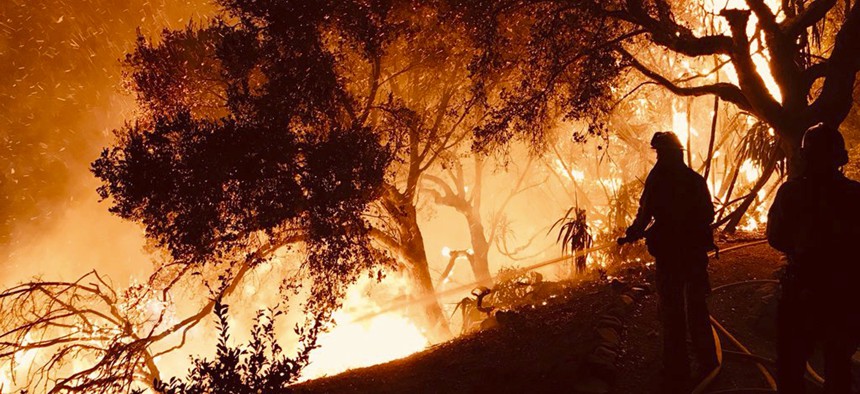U.S. Weather and Climate Disaster Costs Top $300 Billion in 2017

Santa Barbara County Fire Department firefighters knock down flames as they advance on homes atop Shepherd Mesa Road in Carpinteria, Calif. on Dec. 10, 2017. Mike Eliason/Santa Barbara County Fire Department via AP

Connecting state and local government leaders
The figure from NOAA sets a new record.
The cost of major U.S. disasters last year involving weather and climate cleared $300 billion, far surpassing a previous high mark, according to a report the National Oceanic and Atmospheric Administration released Monday.
NOAA said the nation experienced 16 weather and climate disasters in 2017 with losses of $1 billion or more. Among the individual events were severe storms, floods, crop freezes, drought and wildfires.
Costs from these events totaled an estimated $306 billion.
Major contributors to the total include an over $125 billion price tag from Hurricane Harvey, which caused catastrophic flooding in and around Houston, and western wildfire costs of nearly $18 billion.
Since 1980, the U.S. has seen 219 weather and climate disasters with damage costs of $1 billion or more—after factoring in inflation.
The previous overall record for annual costs from these events was an inflation-adjusted $215 billion in 2005, the year that Hurricanes Katrina, Rita and Wilma all struck the U.S.

"No matter how you cut 2017, it was very historic, and perhaps even unprecedented in some ways," Adam Smith, an economist with NOAA's National Centers for Environmental Information, said Monday as he discussed the report's findings on a call with reporters.
Last year was the third-warmest year in the lower 48 states since record keeping began in 1895, based on a preliminary analysis NOAA also released on Monday.
The average annual temperature for the mainland U.S. was 54.6 degrees, 2.6 degrees above the 20th century average.
Arizona, Georgia, New Mexico, North Carolina and South Carolina had their warmest years on record, according to NOAA.
"In 2017, every state in the lower 48 had an average temperature that was above average and this is the third consecutive year that has been the case," noted Jake Crouch, a climate scientist, with the Centers for Environmental Information.
Smith explained that NOAA's cost estimates for billion-dollar-plus disasters are built using a range of information, such as property, flood and crop insurance claims and reporting from state and local emergency management agencies.

There were at least 362 deaths directly linked to the 16 disasters included in the agency's report.
The report does not offer conclusions about what portion of last year's major disaster costs are due to climate change, as opposed to other factors like where development is located, or population trends.
"We do not try to parse those apart," said Deke Arndt, a chief scientist in the Centers for Environmental Information's monitoring section. "We're really just more interested in quantifying what's going on."
More information about NOAA's findings can be found here.
This story has been updated.
Bill Lucia is a Senior Reporter for Government Executive's Route Fifty and is based in Washington, D.C.

NEXT STORY: Mapping the Post-Wildfire Landslide Risk in California’s Burn Zones





